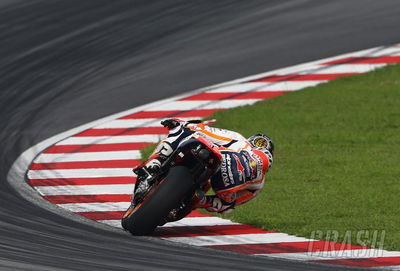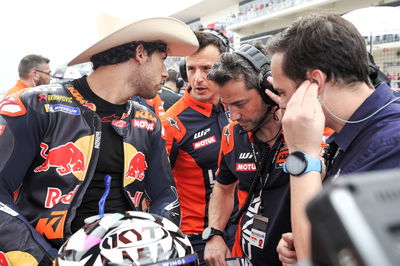Sepang: The Drying Game

Sepang, home of the Malaysian MotoGP and first official test of each season, was completely resurfaced in 2016.
The new asphalt has been widely praised for its high grip, especially in the wet, with camber and kerbing improvements undertaken at the same time.
The problem is when it rains. Or more precisely, after it rains.
The circuit seems slower to dry, resulting in some lost mornings at the recent test, plus persistent wet patches at Turn 9 and a damp joint running between two visibly different types of asphalt on the main straights.
Here, Jarno Zaffelli of Dromo Circuit Design explains the cause of each issue and what can be done.
But first an overview of the parties involved: "We were the track consultant for SIC and the contractor was Nippon Road," Zaffelli said. "SIC is the contract holder with Nippon Road. So what we did, every day, was write reports for SIC saying 'this was not good, this was good'.
"It is up to SIC now to force Nippon Road to fix what they've built not according to the specifications, and they are working on it."
Good morning Ducatisti from @sepangcircuit. Today the weather is fine but the track not yet.. #forzaducati pic.twitter.com/x3MbVMT1hs-- Ducati Motor (@DucatiMotor) January 27, 2017
"Firstly, I don't know why the expectation of everybody is that Sepang will be dry in one hour! I mean, cloudy weather, only 25-degrees of asphalt in the morning, no wind, where will the water go?
"When we designed it we asked for a bitumen that was more hard and with more performance to last more than the previous surface and protect the track. We knew that in tropical weather we'd need it, but we didn't really get tropical weather yet! They told me the rain season is longer in years.
"So in particular weather conditions like this, relatively cool temperatures and strong humidity, it's not working as designed. But if you look at Turn 12 there is an asphalt runoff made in 2007. If you watch it dry it is not so much faster than the new surface, and when it dries it is full of patches, more than the new one.
"However, I understand the separate issue of visibility; the riders cannot see the damp patches on the new surface because it is black. The surface is still black because the bitumen is still there. It has not had enough time to age.
"Then when you put water on top of rubber, like the bitumen here, the droplets are drawn together in big groups instead of being split like grains of sand, which allows them to more easily disperse, absorb and evaporate.
"If the droplets of water are very big it takes a very long to evaporate.
"When we did Misano we discovered it was actually slower to dry than here. But we didn't receive complaints because Misano is much smaller - 12 metres wide and 4.2km long, Sepang is 16 metres and 5.5km - so the time to take away the bitumen from the aggregate was much less and it aged more quickly.
"Here the asphalt is still black after one year."
What can be done?
"One option is simply to wait, because we made an aging test on the asphalt and this showed us that it is improving and becoming easier to evaporate. But we can also accelerate the aging.
"Last year they resurfaced the Red Bull Ring with what I would call a 'German package' of asphalt. The kind they use on German roads, which is very compact and very smooth.
"I was there for the F1, there was a big thunderstorm and everybody was out with wet tyres. They couldn't do 50 metres without spinning because the track surface was so compact, newly done and so on. There was so little texture that the water was producing this film.
"If it had rained for the MotoGP in Austria it would have been a mess, so after the F1 they asked Franco [Uncini, FIM safety officer] if they could apply sandblasting or wet jetting, like they do every year in Singapore for the F1, just to take away the bitumen. This way they artificially age the surface by taking away this film.
"So it is possible to do that here as well. Sepang is a bit slower in the decision process, it's also between the government and the company to understand the compromises to be accepted. We are being as supportive as we can, which is why we are here [at the test]."
"It's like having a rice cake without the honey! So the water is filling the rice and standing there because it has nowhere to go. It is sealed underneath. So the problem is this; the water should not go from the top [of the asphalt] to the lower level, into the 'rice cake'. These damp patches are an issue and they have to fix it."
What can be done?
"They tried to insert drainage underneath the kerb, because they thought the asphalt where it is porous was draining water on the sides. It didn't work because the porous area is confined. That's why at T9 we did some cuts.
"Often damp patches can change a lot over time. For example, at Arrabbiata 1 at Mugello, after repaving we had a very big damp patch in the middle of racing line. It lasted three months. That's all. But to predict what will happen is impossible, because there are so many variables.
"So the next step here will be to seal the 'holes' with a product they are developing with Shell, because it needs to be chemically compliant with the bitumen. The track would only need to be closed for some days to do resurfacing work at T9."
Note the damp line in the centre of the track. The slow drying surface is a concern ahead of official #MotoGP testing at Sepang on Monday. pic.twitter.com/RdipTmIGFb-- Crash.net MotoGP (@crash_motogp) January 29, 2017
"You can see the difference in asphalt on the main and back straights. They are different because on the last day the contactor missed a compound. When we discovered it, during our tests, there were only two days before opening the track.
"The right side [of the track] is wrong and water is seeping out along the joint in the middle of the track."
What can be done?
"When we found the compound problem on the straights the decision was whether to ask Nippon Road to redo the section and delay opening the track. But Superbike was coming soon and there was not enough time available."
What happens next:
"Sepang is now waiting for feedback from the contractor. We had a meeting with both the circuit and the contractor and gave our directions for fixing the issues. The main focus is of course T9 and the main straights. It will take a couple of weeks to understand their decision."
The positives:
"The number of crashes during the past year has been much less, grip in both wet and dry is fantastic, bumps are gone and the highest top speed has been reduced to 327km/h, so also the work we did in Turn 15 worked as designed to slow the riders down.
"Also, during severe wet conditions the track 'resists' more and the MotoGP race of 2016 was not red flagged as in 2012."
The Malaysian MotoGP, the penultimate round of this year's world championship, will be held at Sepang on October 27-29. The F1 race takes place on October 1.
Marc Marquez's 2017 MotoGP title defence starts... by Crash_net












